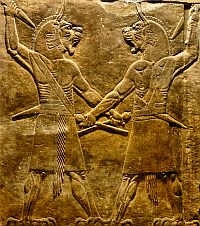Wikipedia
R.H. Allen:
Star Names
Ian Ridpath:
Star Tales
Universe Guide
Sea and Sky:
Constellations
IAU
Map
|
Wikipedia |
R.H. Allen: Star Names |
Ian Ridpath: Star Tales |
Universe Guide |
Sea and Sky: Constellations |
IAU Map |


|
|
Canis MinorStar Lore |
|


|
Canis Minor is small constellation in the northern celestial hemisphere. Its
name is Latin for "Lesser Dog," in contrast to Canis Major, the "Greater Dog." The constellation's main star Procyon ( α CMi) is the eighth-brightest star in the night sky. |


|
|
Ancient Mesopotamia
In the Mesopotamian Three Stars Each table, dating to around 1200 BC,
Procyon and Gomeisa were named
MASH.TAB.BA., meaning "twins."
|
 Ugallu and Lulal, Nineveh, 645 BC
Ugallu and Lulal, Nineveh, 645 BCSource: Jonathan Cohen |


|
|
Ancient Egypt According to Mark R. Chartrand, the ancient Egyptians thought of this constellation as Anubis, the jackal god. Source: Wikipedia |
 Anubis Statue, Vatican Museums
Anubis Statue, Vatican MuseumsSource: Wikipedia |


|
|
Greek Mythology
The earliest Greek records by Homer, Hesiod and
Aratus refer to Canis Major and
Canis Minor as Orion's hunting dogs, pursuing
Lepus the Hare or helping Orion fight
Taurus the Bull.
|
 Orion and his hunting dogs
Orion and his hunting dogsSource: Bob Moler's Ephemeris Blog |
...In a famous legend from Attica ..., recounted by the mythographer
Hyginus, the constellation represents
Maera, dog of Icarius,
the man whom the god Dionysus first taught to make wine. When Icarius gave his wine to some
shepherds for tasting, they rapidly became drunk. Suspecting that Icarius had poisoned them, they killed him.
 Maera the dog ran howling to Icarius’s daughter Erigone, caught hold of her dress with his teeth and led her to her father’s body. Both Erigone and the dog took their own lives where Icarius lay.  Zeus placed their images among the stars as a reminder of the unfortunate affair.  [End of Ian Ridpath quote]
|
 Canis Minor in "Urania's Mirror", 1824
Canis Minor in "Urania's Mirror", 1824Source: Wikipedia |

The name Procyon (α CMi) comes from the Greek Prokyon (Προκύων), meaning "before the
dog," referring to the star's rising before the "Dog Star" Sirius (α CMa).
 Source: Wikipedia |

Some sources like greekmythology.wikia connect Canis Minor with the
Teumessian Fox, a beast turned into stone with its hunter,
Laelaps, by Zeus, who placed them in heaven as Canis Major (Laelaps) and Canis Minor
(Teumessian Fox), where they are destined to chase each other for eternity.
 For the full story on the Teumessian Fox, see Canis Major.  Sources: Ian Ridpath, Wikipedia |

|
 The Teumessian fox and Laelaps, the dog; greekmythology.wikia |


Middle East and Asia |
|
|
Arabian Peninsula
The stars of Canis Minor are part of the ancient Arab legend of Jawza'.
|

|
|
Medieval Arab Astronomy
The medieval Arabic astronomers maintained the depiction of Canis Minor (al-Kalb al-Asghar in Arabic) as a dog; in his
Book of the Fixed Stars,
Abd al-Rahman al-Sufi included a diagram of the constellation with a canine figure
superimposed.
|
 Canis Major in Pergamenthandschrift M II 141,
Canis Major in Pergamenthandschrift M II 141,a 15th century copy of al-Sufi's drawing Source:atlascoelestis.com |


|
|
Ancient China
In Chinese, Canis Minor is written
小犬座
Procyon along with Gomeisa and Epsilon Canis Minoris formed Nanhe, the
southern river (the northern river, Beihe, included Castor and Pollux in Gemini.
Lying either side of the ecliptic, Nanhe and Beihe were also interpreted as gates or sentries.
|


Africa |
|
|
/Xam
To the /Xam people of southern Africa the bright stars Castor (α Gem) and
Pollux (β Gem) were two female
eland antelopes with Procyon (α CMi), the
bright star in Canis Minor being their male companion.
|

|


 |
Sotho, Tswana
The Basuto, Lobedu,
Northern Sotho and Tswana
had a constellation called Magakgala or Mahakala that was formed by the four bright stars
Procyon (α CMi), Betelgeuse (α Ori),
Rigel (β Ori) and Sirius (α CMa).
|
 |


Australia |
|
|
Wardaman
The Wardaman people of the Northern Territory gave Procyon and
Gomeisa the names Magum and Gurumana, describing them as humans who were transformed
into gum trees (Eucalyptus) in the dreamtime.
|
 Gum Tree
Gum Tree© Gale Sutton |


Pacific |

|
|
In Māori, Procyon is
called Puanga-hori, meaning the "False Puanga" (Puanga is the name for Rigel (β Orionis).
 On Tahiti, Procyon is one of the ten pilars that hold up the sky like pilars hold up a traditional Polynesian roundhouse. It is called Ana-tahua-vahine-o-toa-te-manava, literally "Aster the priestess of brave heart", figuratively the "pillar for elocution."  Sources: Wikipedia, Maori Star Names, Rongorongo, Polynesian Star Catalog
|

|


North America |


|
|
Ojibwe
On the Ojibwe Star Map, Procyon (α CMi)
together with Aldebaran (α Tau),
and the stars of Orion,
are called Biboonkeonini, the Winter Maker, as their presence in the
night sky heralds winter.
|

|


|
|
Navajo
Tăish Tsoh, the Big Snake constellation is located in the southern sky made of parts of the Greek constellations
Puppis and
Canis Major.
|

|



|
|
Flags and other National Symbols
The center of the Brazilian flag presents the night sky as it would have been on November 15, 1889 at 08:30 over Rio de Janeiro. Each star corresponds
to a Brazilian Federate Unit, sized in proportion relative to its geographic size.
|

|

|


|
|
Modern Day Fiction In the Star Trek Universe, Andoria, a moon orbiting the eights planet of Procyon is the home world of the Andorians, one of the four founding members of the United Federation of Planets.
Another (fictional) planet of the Procyon system is the scene of the Battle of Procyon V in the episode
Azati Prime of the TV series Star Trek: Enterprise.
|

|


|
Back to Star Lore |
Back to Mythology |
Back to Space Page |
Back to English |
 Back to Start Page |